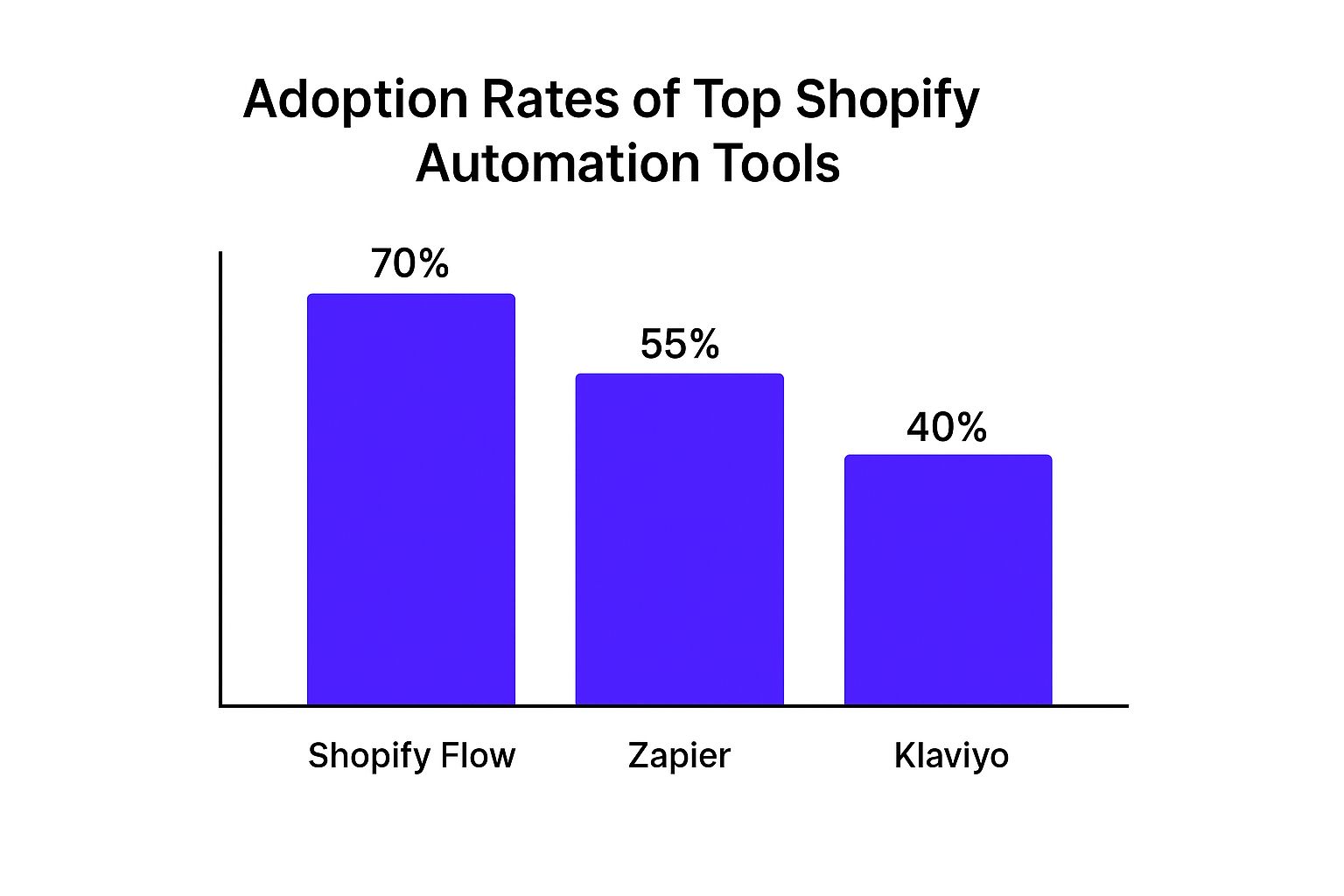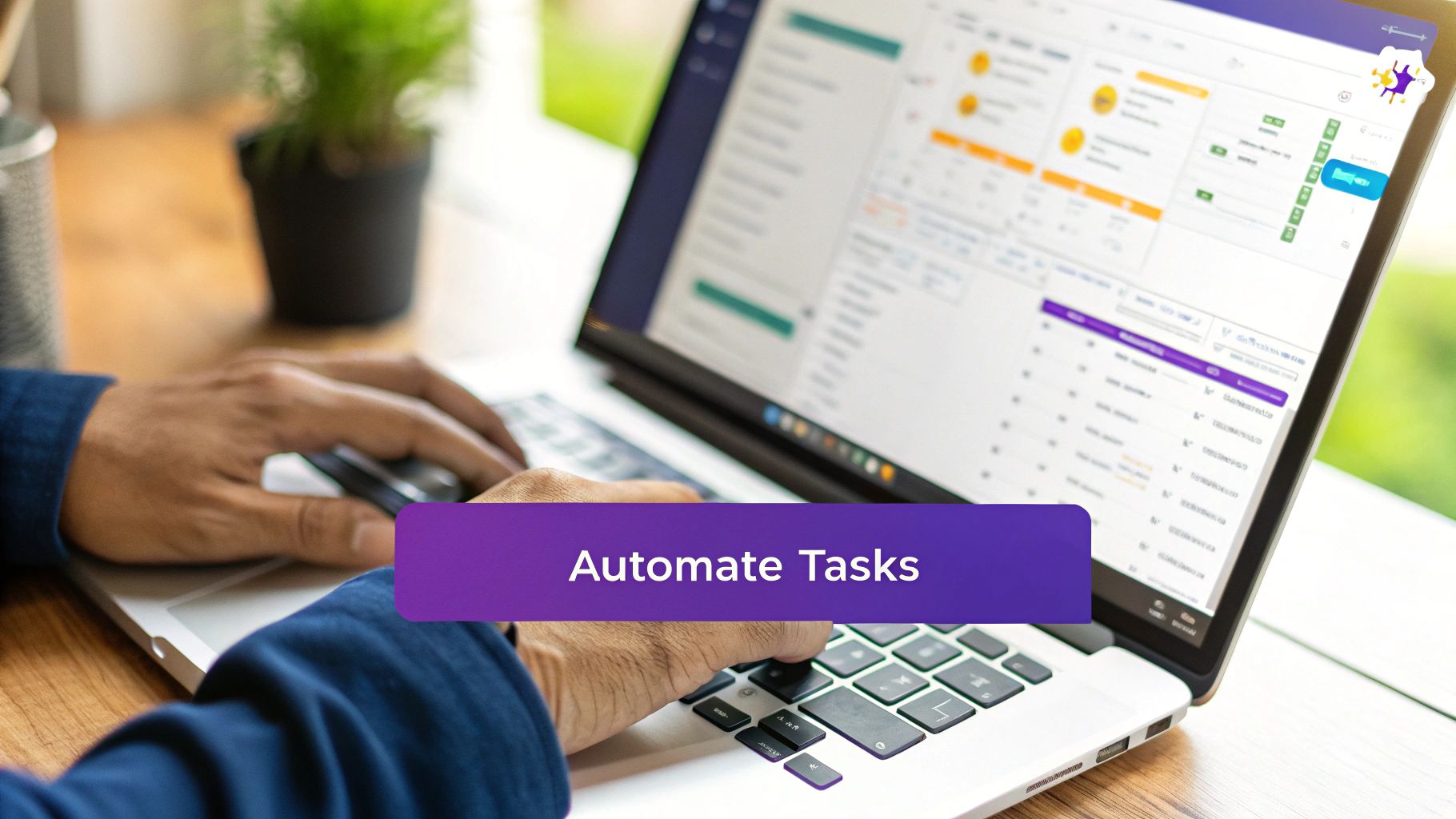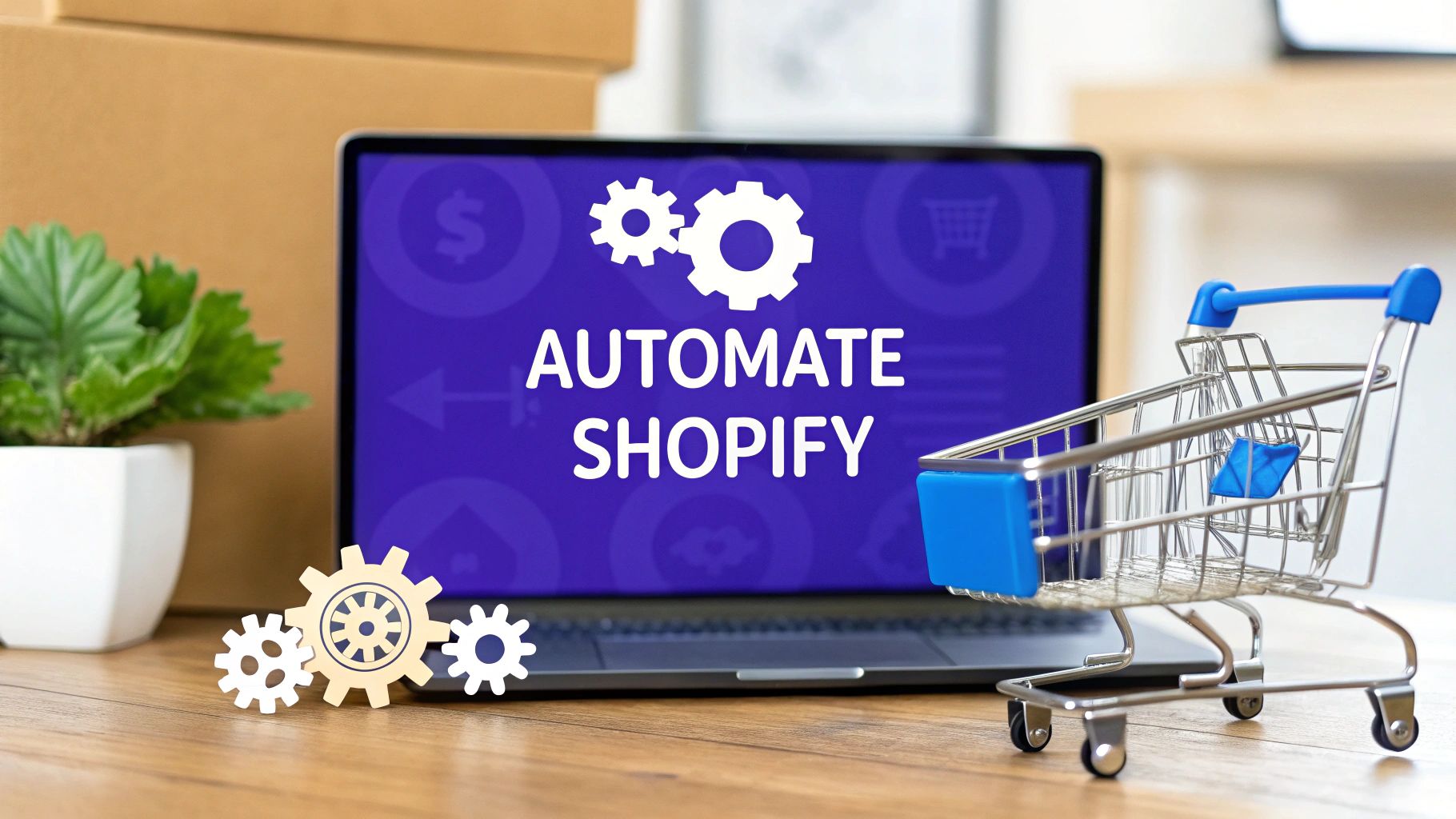Why Smart Merchants Are Choosing Automation Over Manual Tasks
Running a Shopify store often feels like a constant juggling act. Between managing inventory, fulfilling orders, marketing products, and providing customer support, it can be tough to find time to actually grow your business. This is where automation comes in. It's not about working harder; it's about working smarter.
Reclaiming Your Time and Resources
Think of manual tasks as tiny leaks, slowly draining your valuable resources. Individually, they may seem insignificant. But collectively, these tasks consume significant time and money. Manually processing orders, sending marketing emails, and updating inventory, for example, can eat up hours each day. Automating these tasks frees you to focus on more strategic activities, such as product development and long-term planning. When starting to automate your Shopify store, consider the account creation process. Learn how to Create a Shopify store with no mobile number.
The Competitive Edge of Automation
In the fast-paced world of ecommerce, speed and efficiency are key. Automation offers a competitive advantage by streamlining operations and enabling more effective scaling. Imagine launching new products, running marketing campaigns, and responding to customer inquiries faster than your competition. That's the power of automation at work. Speed is particularly important in the rapidly expanding ecommerce market. For more information, check out these global ecommerce statistics. By 2025, the global ecommerce market is expected to reach $4.8 trillion, with Shopify supporting over 2 million active merchants. This growth highlights the importance of efficient, scalable solutions like automation.
From Struggling to Thriving: Real-World Examples
Many Shopify stores have gone from struggling to thriving by implementing smart automation. Take, for example, a small clothing boutique that was struggling with inventory management. By automating their reordering process, they eliminated stockouts, improved customer satisfaction, and ultimately, boosted sales. This illustrates how automation can unlock a business's true growth potential.
Beyond the Basics: Unleashing the Full Power of Automation
Automating basic tasks is just the first step. Savvy merchants are using automation to personalize customer experiences, optimize marketing campaigns, and gain valuable business insights. For instance, automated email sequences can nurture leads and drive conversions, while automated customer segmentation allows for more targeted marketing. These advanced automation strategies can truly elevate your business.
Marketing Automation That Actually Converts Browsers Into Buyers

For Shopify store owners, moving past basic email marketing opens exciting new opportunities for automation. It's about crafting dynamic, personalized shopping experiences that truly connect with each customer, guiding them smoothly toward a purchase. But, the truth is, not every automation strategy delivers the same results. This section explores the workflows that truly drive conversions.
Personalized Customer Journeys Through Smart Segmentation
Imagine your marketing messages feeling like personalized recommendations instead of generic emails. This is the potential of customer segmentation. By grouping your audience based on shared traits, you can create targeted content that resonates with their specific needs and interests. This focused strategy can significantly boost engagement and improve conversion rates. For example, welcome new customers with helpful product information, while offering returning customers exclusive deals and new arrival updates.
Behavioral Triggers: Reaching Customers at the Right Moment
In marketing, timing is key. Behavioral triggers empower you to automate messages based on specific customer actions. This ensures the right message arrives precisely when it's most effective. A classic example is the abandoned cart email. These automated reminders nudge customers about items left in their cart, often sweetening the deal with a small incentive. You can also trigger personalized product recommendations based on browsing history or past purchases. Interested in learning more about sales strategies? Check out this article: How to Increase Shopify Sales: Top Strategies for Growth.
From Abandoned Carts to Raving Fans: Automating the Entire Sales Funnel
Marketing automation can optimize your entire sales process, from the first point of contact to post-purchase follow-up. Abandoned cart reminders are just the starting point. Consider automating these as well:
- Dynamic product recommendations: Suggest related or similar items based on individual customer behavior.
- Review collection: Encourage satisfied customers to share their positive experiences, building social proof and driving future sales.
- Loyalty programs: Automatically reward repeat customers, fostering brand loyalty and increasing customer lifetime value.
These automated systems work in concert to create a seamless customer experience that encourages repeat business and fuels sustainable growth. Marketing automation is now a cornerstone of growth in the competitive ecommerce world. Automated tools within Shopify facilitate personalized customer journeys, leading to higher engagement and conversions. Automation also enhances efficiency by reducing manual tasks, freeing up store owners to focus on strategic initiatives. Learn more about the power of marketing automation.
Choosing the Right Tools for the Job
The sheer number of available marketing automation tools can be overwhelming. Focus on tools that seamlessly integrate with your Shopify store and offer the features you need. Consider these factors:
- Ease of use: Is the platform intuitive and user-friendly?
- Scalability: Can the tool adapt and grow as your business expands?
- Reporting and analytics: Does it offer valuable insights into campaign performance?
- Customer support: Is reliable support readily accessible when you need it?
By selecting the right tools and using them strategically, you can transform your Shopify store into a powerful, automated engine that generates leads, converts browsers into loyal customers, and builds lasting relationships.
Inventory and Fulfillment Systems That Run Themselves

The chart above illustrates the increasing popularity of Shopify automation tools. Shopify Flow leads the pack at 70% adoption, followed by Zapier at 55% and Klaviyo at 40%. This trend underscores the growing recognition of automation's power to enhance store operations. Effective stock management is the backbone of any thriving online store. Thankfully, the right tools can transform inventory and fulfillment from a headache into a smoothly running operation.
Automating Reorder Points: Preventing Stockouts Before They Happen
Imagine never running out of your best-selling products. Automated reorder points make this a reality. By setting inventory thresholds, your system automatically sends purchase orders to suppliers when stock runs low. This proactive approach ensures you always have enough inventory to meet customer demand, preventing lost sales and frustrated shoppers.
Streamlining Supplier Integration: Building Seamless Partnerships
Direct integration between your inventory system and your suppliers elevates automation to a new level. This real-time connection provides up-to-the-minute visibility into supplier stock levels. This information allows for more precise forecasting and automated ordering. For instance, if a supplier encounters a delay, your system can automatically adjust reorder points, proactively avoiding disruptions.
Fulfillment Workflows That Keep Customers Happy
Automated fulfillment workflows ensure orders are processed and shipped quickly and efficiently. Key features include automated order confirmation emails and real-time shipping updates, keeping customers informed every step of the way. These automated systems can even generate return shipping labels, simplifying the returns process for a better overall customer experience. For businesses interested in extending automation to marketing, exploring the impact of social media for dentists can be insightful.
Mastering Multi-Channel Selling and Dropshipping Automation
Selling across multiple platforms requires automated inventory synchronization. This critical function prevents overselling and ensures accurate stock information across all channels. Dropshipping automation offers similar benefits, streamlining order routing, tracking updates, and returns processing. This leads to a smoother experience for both the merchant and the customer.
Choosing the Right Inventory Tools for Your Business
Selecting the right inventory tools is fundamental to successful automation. Prioritize features like real-time reporting, seamless integration with other platforms, and scalable solutions that grow with your business. Choosing the right tools optimizes your inventory management, unlocking greater efficiency and profitability.
To help illustrate the benefits of automation, let's take a look at the following comparison:
Key Inventory Automation Features Comparison: This table compares essential inventory automation features and their impact on store operations.
| Feature | Manual Process Time | Automated Process Time | Error Reduction |
|---|---|---|---|
| Generating Purchase Orders | 2 hours/week | 5 minutes/week | 90% |
| Updating Stock Levels Across Sales Channels | 1 hour/day | 1 minute/day | 95% |
| Processing Returns | 30 minutes/return | 5 minutes/return | 80% |
| Sending Order Confirmations | 5 minutes/order | Instant | 99% |
As you can see, automating key inventory processes significantly reduces processing time and drastically minimizes errors. This translates to increased efficiency, improved accuracy, and ultimately, higher profitability. Choosing the right automation tools empowers businesses to optimize their operations and focus on growth.
Customer Support Automation That Customers Actually Love

Modern customer support automation focuses on creating positive and helpful experiences. The goal isn't just about saving your team time; it's about ensuring genuine customer satisfaction. This shift requires moving beyond basic chatbots and embracing intelligent systems that provide real value.
Building a Support System That Works for Everyone
Smart business owners understand that automation isn't meant to replace human interaction completely. Instead, it's about efficiently handling routine inquiries. This frees up human agents to address more complex problems that require a personal touch.
For example, an automated system can handle simple questions about shipping costs or return policies. Meanwhile, a human agent can step in to resolve a complicated technical issue or offer personalized advice. This balanced approach ensures efficiency and maintains a human connection.
FAQs That Learn and Adapt
Instead of static FAQs, envision a system that dynamically updates based on actual customer questions. This FAQ automation analyzes incoming inquiries, identifying common themes and areas where information might be lacking.
Over time, the system becomes more accurate and comprehensive, providing increasingly relevant answers. This means customers quickly get the information they need, leading to reduced frustration and increased satisfaction.
Intelligent Ticket Routing: Getting Problems to the Right Person Immediately
When customers need specialized assistance, intelligent ticket routing ensures their issue goes directly to the right agent. This automated system analyzes the content of support tickets and categorizes them based on the issue.
Tickets are then routed to the appropriate team member based on their area of expertise. This streamlines the support process and minimizes the frustration of being transferred between multiple agents. You might be interested in: How to master customer onboarding automation.
Proactive Support: Solving Problems Before They Arise
Often, the best support is the support customers never have to request. Proactive support anticipates and addresses potential issues before they become major problems.
For example, if a shipping delay occurs, the system can automatically notify affected customers. Providing updates and offering solutions proactively builds trust and demonstrates a commitment to customer care.
Multilingual Support and Continuous Improvement
In today's interconnected world, multilingual support automation is key for reaching a global audience. Automated translation tools and multilingual chatbots can help overcome language barriers, making support accessible to everyone.
Moreover, automated feedback systems can gather valuable data from customer interactions. These insights can then be used to continuously improve your support system, ensuring it adapts to the ever-changing needs of your customers.
Data Tracking Systems That Guide Smart Business Decisions
For sustainable growth, successful Shopify store owners know they need to make data-driven decisions. Relying solely on intuition can be a risky strategy. This section explores how automated data tracking systems can give you valuable insights into your store's performance.
Monitoring Key Metrics Automatically: A Real-Time Pulse on Your Business
Setting up comprehensive tracking lets you monitor essential metrics automatically. This could include anything from website traffic and conversion rates to average order value and customer lifetime value. Imagine a real-time dashboard providing an up-to-the-minute view of your store's performance. This empowers you to identify emerging trends, spot potential issues, and make informed choices rapidly.
Identifying Trends and Anticipating Market Shifts
Automated tracking doesn't just show you the present; it helps you predict the future. By analyzing past data, you can spot patterns and anticipate shifts in customer behavior or market demands. This foresight is essential for proactively adapting your products, marketing campaigns, and overall business strategies. You can stay ahead of the competition by reacting to changes before others even notice them.
Conversion Tracking Beyond the Basics: Understanding Customer Behavior
Effective conversion tracking goes deeper than simply counting purchases. It's about understanding why customers convert – or why they abandon their carts. Analyzing customer behavior, such as navigation patterns, time spent on pages, and interaction with product descriptions, provides insights into what works and what needs improvement. For instance, if customers frequently abandon carts at the shipping stage, it might suggest a problem with your shipping options or clarity of information.
Competitive monitoring is also crucial for staying ahead of market changes. Tracking your competitors' pricing, products, and marketing efforts provides valuable context for your own decisions. This information helps you identify opportunities to differentiate your store and capitalize on competitor weaknesses. Shopify’s ability to maintain high user engagement and conversion through automation is crucial for merchants in today's competitive market. In 2025, Shopify reported approximately 2.1 million daily active users and high-performing stores saw conversion rates exceeding 4.7%. Automation tools significantly contribute to these figures by optimizing processes and improving the user experience. Find more detailed statistics here.
Building Actionable Dashboards and Reports: Transforming Data into Decisions
Raw data is only valuable if you can understand and act upon it. This is where dashboards and reports are vital. They translate your data into easy-to-understand visuals. A well-designed dashboard offers a snapshot of key metrics, highlighting areas needing attention. Automated reporting systems boost efficiency by regularly generating reports on specific metrics, saving you time and improving accuracy.
From A/B Testing to Predictive Analytics: Advanced Automation for Growth
Automated A/B testing simplifies store optimization. You can automatically test various versions of website elements like headlines, images, or call-to-action buttons. This reveals which versions perform best, continually improving conversion rates. Predictive analytics takes this a step further by using historical data to forecast future sales trends. This helps you make smart decisions about inventory, marketing budgets, and staffing.
By implementing these data-driven strategies, you can transform your Shopify store into a highly efficient operation that's constantly learning, adapting, and growing.
Your Step-by-Step Blueprint for Automation Success

Ready to automate your Shopify store but feeling a little lost? This section offers a clear roadmap to guide you through a practical implementation process. We'll focus on respecting your current workflow and budget, emphasizing smart choices that deliver tangible results.
Auditing Your Current Processes: Identifying High-Impact Opportunities
The first step towards successful automation is understanding your existing workflows. Consider it a thorough assessment of your business operations. Where are you spending the most time and resources? These are the areas ripe for automation.
For example, are you manually fulfilling orders every week, losing valuable time you could be spending elsewhere? Perhaps managing inventory feels like a constant uphill battle. Identifying these pain points is the foundation of an effective automation strategy.
Prioritizing Implementations Based on ROI: Getting the Most Bang for Your Buck
Not all automation projects offer the same return. Some provide quick wins and impressive ROI, while others demand more time and investment. A priority matrix can help you strategically decide where to focus your efforts.
Prioritize automating tasks with a high business impact and relatively easy implementation. This allows you to quickly see the benefits and gain momentum for more complex projects down the line.
Testing and Training: Avoiding Costly Mistakes and Ensuring Smooth Transitions
Before launching any automation, thorough testing is crucial. This prevents unforeseen errors and ensures a smooth transition for your team. Think of it as a final check before going live.
Training your team is equally vital. Provide clear instructions and support to ensure everyone understands the new automated systems. This minimizes disruptions and maximizes your investment.
Maintaining the Human Touch: Balancing Automation with Personalized Experiences
While automation streamlines tasks, customers still value personal connections. The key is finding the right balance. Automate repetitive, time-consuming tasks, but maintain a personal touch in crucial areas like customer support and relationship building. This keeps your store efficient and customer-centric.
Scaling and Measuring Success: Adapting to Growth and Tracking Your Progress
As your business grows, your automation needs will change. Choose scalable solutions that can adapt to increasing demands. Regularly review your automated systems and make adjustments as needed, ensuring your strategy aligns with your business goals.
Tracking your progress is essential. Monitor key metrics to measure the impact of your automation efforts. This provides data for refining your strategies and maximizing ROI.
This table, the "Automation Implementation Priority Matrix," helps prioritize automation features based on implementation difficulty and potential business impact:
| Automation Type | Implementation Difficulty | Business Impact | Recommended Timeline |
|---|---|---|---|
| Abandoned Cart Emails | Low | High | Immediate |
| Automated Order Fulfillment | Medium | High | Within 1 month |
| Inventory Management System | High | High | Within 3 months |
| Customer Segmentation for Marketing | Medium | Medium | Within 2 months |
| Chatbot for Customer Support | Low | Medium | Immediate |
The table highlights key areas to focus on for immediate gains, such as abandoned cart emails and chatbots, while outlining a longer-term strategy for more complex implementations like inventory management. This phased approach ensures a balance between quick wins and sustainable, long-term improvements.
This structured approach empowers you to automate your Shopify store strategically, maximizing efficiency and driving growth without losing the personalized touch your customers value.
Ready to seamlessly integrate courses and communities into your Shopify store? Tevello offers an all-in-one platform to expand your selling potential through digital education and automated customer experiences. Learn more about Tevello and how it can transform your Shopify store.




